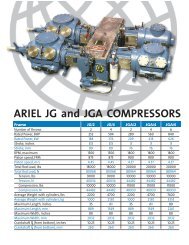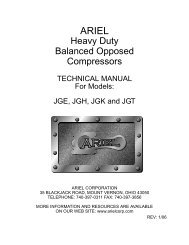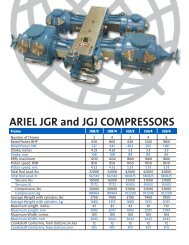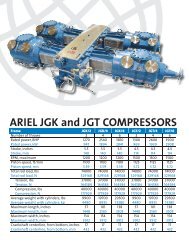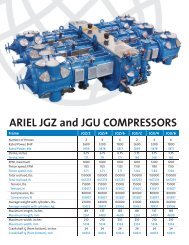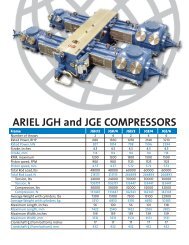Heavy Duty Balanced Opposed Compressors
Heavy Duty Balanced Opposed Compressors
Heavy Duty Balanced Opposed Compressors
Create successful ePaper yourself
Turn your PDF publications into a flip-book with our unique Google optimized e-Paper software.
FOR MODELS: JG AND JGA SECTION 5 - MAINTENANCE<br />
Valves<br />
Valves - Removal<br />
1. Slightly loosen all of the bolts on each valve cap. With all the bolts loose, the cap<br />
should stay in its original position. If it pushes out on its own accord-stop! Take<br />
steps to completely vent the cylinder. See Caution above. A typical valve<br />
assembly is shown in Figure 5-18: on Page 5-33.<br />
2. After all the above safety checks, remove the valve cap bolts. A pair of prybars<br />
(or screwdrivers), one on each side of the cap, will help pry it loose. With the<br />
retainer still in place, screw a valve tool over the valve center bolt. See Figure 7-<br />
1: on page 7-3. Now the valve and retainer can be pulled out together. For cylinder<br />
class 1-3/4JG-FS-HE and 2-1/2JG-FS-HE tandem cylinders, the suction and<br />
discharge piping and cylinder head must be removed to gain access to the concentric<br />
valve. A concentric valve combines the suction and discharge valves in<br />
one assembly. See Caution at “Piston and Rod - Removal” on page 5-18.<br />
3. In most cases the flat metal gasket will remain in the pocket. It is difficult to see.<br />
A flashlight and a small mirror on an adjustable rod are the best tools to see the<br />
gasket clearly. On cylinders with horizontal valves, the gasket may fall into the<br />
gas passage. A small magnet on a flexible extension rod will help fish it out. This<br />
gasket should be replaced after several uses.<br />
Valves - Maintenance<br />
!<br />
CAUTION<br />
BEFORE ATTEMPTING TO REMOVE ANY VALVE CAP, BE<br />
CERTAIN THAT ALL PRESSURE HAS BEEN VENTED FROM<br />
THE COMPRESSOR CYLINDER. THE PRESSURE MUST BE<br />
COMPLETELY VENTED FROM BOTH THE SUCTION AND<br />
DISCHARGE PASSAGES OF THE CYLINDER. SEE FIGURE 1-<br />
3: ON PAGE 1-3 FOR LOCATION OF IMPORTANT SAFETY<br />
INFORMATION PLATES.<br />
Ariel uses valves manufactured by Hoerbiger Corporation. Before servicing any valve refer<br />
to the correct valve assembly drawing and parts list and Hoerbiger's literature in the Parts<br />
Book. On the valve assembly drawing you will notice that valves have different springing for<br />
different pressure levels. The cylinder cover sheet in the Parts Book lists the valve originally<br />
supplied with each cylinder. If different operating pressures are encountered, then different<br />
springs may be required.<br />
The suction valve must be selected on the basis of operating suction pressure and the discharge<br />
valve for operating discharge pressure. Proper valve spring selection is also based<br />
11/01 PAGE 5 - 31





